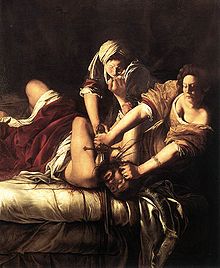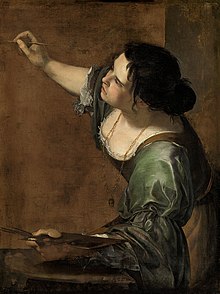Artemisia (film)
| Movie | |
|---|---|
| Original title | Artemisia |
| Country of production | France , Italy , Germany |
| original language | French |
| Publishing year | 1997 |
| length | 102 minutes |
| Rod | |
| Director | Agnes Merlet |
| script | Agnès Merlet, Christine Miller |
| production |
Patrice Haddad , Christoph Hahnheiser , Leo Pescarolo |
| music | Krishna Levy |
| camera | Benoît Delhomme |
| cut |
Guy Lecorne , Daniele Sordoni |
| occupation | |
| |
Artemisia , also known as Artemisia - School of Sensuality , is a historical film from 1997 that was made as a co-production between France , Italy and Germany . The film biography traces the life and work of the Italian painter Artemisia Gentileschi (1593–1653).
action
Italy 1610: After praying in a chapel, the 17-year-old student Artemisia Gentileschi steals a candle. In her chamber she then takes out her painting equipment and looks at herself in a mirror by candlelight. She studies her body and begins to draw it. The nuns of the monastery are outraged when they find the nude drawings and show them to Artemisia's father, Orazio , an established painter. Instead of reprimanding her, Orazio realizes his daughter's talent and decides to teach her in his studio. On a beach, Artemisia meets the young fisherman Fulvio, whom she has known since childhood. When he tells her that her breasts have gotten bigger, she pushes him away and runs away. Shortly afterwards, she discovers a couple making love in a dune and watches with fascination from a cliff edge. After the lovers have gone, Artemisia longingly lies down in the hollow that has remained in the sand.
Since women are not allowed to paint naked men, Artemisia has to stay behind a curtain when Orazio creates a male nude. Since Artemisia desperately wants to draw a male nude, she seeks Fulvio by the rocks on the beach. She offers him the chance to kiss her if he undresses for her in return. Fulvio agrees and takes off his clothes after the kiss. Artemisia studies his body with great concentration. One day on the beach she and Fulvio watch Agostino Tassi paint a model of a ship in front of the setting sun. Inspired by Agostino, Artemisia no longer wants to paint in the studio, but in the garden. She eventually travels to Florence with her father , where Orazio wants to enroll her at the local art academy. However, since women are not allowed to study at the academy, Artemisia is denied admission.
Orazio is commissioned to paint the frescoes of a church together with Agostino Tassi . Artemisia also contributes sketches and thus meets Agostino again. One evening Artemisia sneaks to Agostino's house, where she discovers several men and women having sex through a window. When she also sees Agostino making love with a prostitute, she runs away irritated. Agostino then becomes interested in her work, and Artemisia hopes to become his student. However, he only agrees to become her teacher when Orazio asks him to do so.
From now on, Agostino teaches Artemisia about perspective and teaches her landscape painting with a wire mesh. He also agrees to be the model for her painting Judith and Holofernes . They get closer and Artemisia lets Agostino kiss her. When he penetrates her, however, she shrinks back in pain and beats him - horrified by the blood in her lap. At home, Artemisia tries to process the incident with a drawing. Since she continues to be attracted to Agostino, she eventually lets himself into an affair with him. Orazio, who initially does not believe the rumors about their relationship, finds Artemisia half-naked at Agostino's. Since Agostino refuses to marry Artemisia, Orazio accuses him of raping his daughter.
Agostino protests his innocence in court. To protect him, Artemisia claims to still be a virgin. However, an investigation carried out by two nuns shows that Artemisia is no longer a virgin. On the witness stand, Agostino's sister testifies that Agostino cheated on a woman in Florence and that she cheated on her with her younger sister. Artemisia is shocked to learn that Agostino lied to her and did not want to marry her. She still looks for him in prison and tells him that she still loves him. In the course of the trial, Agostino's lawyer presents Artemisia's male nude drawings that she had made of Fulvio, and in this way wants to portray Artemisia as a woman of dubious reputation. Her painting Judith and Holofernes , which has now been completed, is also intended to show her violent tendencies and portray Agostino as a victim. Since Agostino refuses to testify against Artemisia, the judge leads Agostino and Artemisia into a separate room. To get Artemisia to confess, the judge puts cords around her fingers and pulls them tighter and tighter until Artemisia is bleeding. Agostino can't bear to see her suffer, so he tells the judge that he raped her and promised her marriage. He is then sentenced to two years in prison. Artemisia struggles to get over the breakup with Agostino and to forgive her father, and ultimately decides to leave her father. In Agostino's house she finds the wire mesh that he used to teach her landscape painting, and she takes it to the beach. There she looks through the bars and sees in her mind's eye a landscape with two hills and a tree that Agostino had previously described to her in his prison cell.
background
The shooting took place in the Cinecittà film studios in Rome and Tuscany , for example in the Parco Regionale della Maremma there . Emita Frigato was responsible for the production design, and Dominique Borg designed the costumes .
Artemisia premiered in France on September 10, 1997 and was presented at the Toronto International Film Festival . This was followed by other screenings at film festivals, including the Chicago International Film Festival in October 1997. On May 28, 1998, the film was released in German cinemas.
The film about the first woman, which was officially recorded at the Accademia delle Arti del Disegno in Florence in 1616 , sparked controversy when it was released. The director Agnès Merlet was accused by art historians such as Mary D. Garrard of reducing the film too much to erotic aspects and falsifying historical facts. Artemisia Gentileschi was raped several times by Agostino Tassi and was not, as shown in the film, his lover, according to the surviving court documents. In addition, the film did not sufficiently illuminate Gentileschi's influence and instead attributed the drive for her artistic work solely to her supposed love for Tassi.
Reviews
"In stylish, beautiful pictures that never slide into taste, a biography develops that also asks about artistic concepts of looking at the world," says the lexicon of international film . It is an “impressive work” that is “full of optical finesse” and is carried “by three excellent main actors”. Martin Günther from Cinema found that Agnès Merlet had "very freely processed the (art) historical material into a contemporary drama about emancipation and self-determination" and wished that "every visit to the museum would be as exciting" as these "profound artists -Bio ".
Der Spiegel , on the other hand, criticized the fact that Merlet had invented "a tragic love affair" for the purpose of a dramaturgy suitable for film, "which turns the carefree girl into a mature painter". This feigns depth, "where there is dramaturgical flatness", and is "moreover a daring twisting of the facts". For Prisma was Artemisia , a "fascinating historical drama about a woman [...], the societal boundaries defies her time and full of art and artists surrenders". The film "[d] ank of intoxicating images and erotic enchantment [...] often looks like a painting".
Awards
At the 1997 Chicago International Film Festival , Artemisia was nominated for Best Film for the Gold Hugo, along with films such as Caroline Links Jenseits der Stille and Michael Haneke's Funny Games , which ultimately won Alan Rickman's directorial debut The Winter Guest . Merlet's historical film also received a nomination for the Golden Globe for Best Foreign Language Film in 1998 , but was defeated by the Belgian production Mein Leben in Rosarot . At the César Awards in 1998 , Artemisia was nominated in the categories of Best Cinematography and Best Costumes . However, cameraman Benoît Delhomme and costume designer Dominique Borg were unable to prevail against the competition. Was awarded Artemisia French Best Picture by Roger Le, the price of the Avignon / New York Film Festival.
Web links
- Artemisia in the Internet Movie Database (English)
- Artemisia at Rotten Tomatoes (English)
- Pictures of the film on cinema.de
Individual evidence
- ↑ a b Artemisia . In: Der Spiegel , June 1, 1998.
- ↑ Natasha von Heerden: Artemisia ( memento from January 18, 2016 in the Internet Archive ) on st-andrews.ac.uk
- ^ Artemisia. In: Lexicon of International Films . Film service , accessed February 19, 2020 .
- ↑ cf. cinema.de
- ↑ cf. prisma.de

